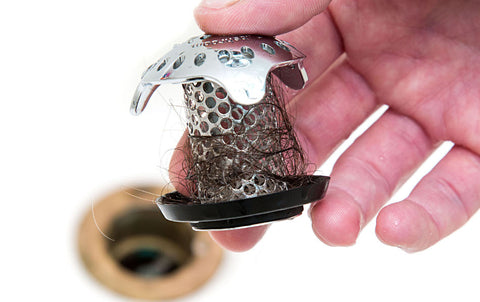
Slow Draining Tub: Causes, Fixes and Prevention
Share
Have you ever had a tub that wouldn’t drain? If so, you are not alone. A slow draining tub is a common problem that renters and homeowners deal with. “Slow draining” means that the water in your tub takes longer than it should to drain after you’ve pulled the plug. In more serious cases, the water could even remain indefinitely. If the drainage problem is not dealt with immediately, it will only get worse with time.
In this article, we will look at common causes of slow draining tubs, how to fix them and how to prevent them in the first place.
Common Causes of a Slow Draining Tub
Here are some of the most common causes of a slow draining tub:
Hair

One of the main culprits of a clogged drain is hair. When you take a shower or shave, you shed strands of hair which go down the drain. As they go down the drain, they are likely to stick to the sides of your piping. Over time, the hair will accumulate and also trap other materials going down the drain. This will hinder proper drainage.
Soap Scum and Shampoo Residue
This is another common reason for clogs on bathtubs. Soap scum and shampoo residue that goes down your drain solidifies and sticks to the sides of your pipes. This could build up over time and cause blockages.
Dirt, Sand and Debris
When your kids play outside, they are likely to carry dirt on their bodies. You will also have dirt or sand on your body when you go hiking or to the beach. When you take a shower, this debris could accumulate in your drain and cause problems down the line.
Hard Water
Believe it or not, water can actually cause problems in your bathtub. Hard water contains high concentrations of calcium, magnesium, and other minerals. Though you cannot see them with your naked eye, such minerals can prove costly. Just like soap scum and hair, the minerals stick to the sides of your pipes and accumulate over time. This could eventually result in blockage of your drain.
Sewer Line Problems
Sewer lines are responsible for carrying away waste water and sewage from your home. Sludge buildup (due to the solids flushed down your sewer system) and tree roots can slowly block your sewer pipes. This could lead to slow drains in your home.
Clogged Vent Pipes
Vent pipes are responsible for equalizing air pressure in your drain pipes to prevent a vacuum effect from disrupting drainage. However, since a vent pipe extends through the roof, it can be clogged by leaves, sticks and other debris. Blockages can also be caused by animals or insects. When this happens, it could cause your household plumbing to drain slowly.
How to Fix a Slow Draining Tub
You don’t have to call the plumber immediately when you realize your tub isn’t draining. You can identify the problem and fix it using simple home remedies. Here are some ideas to explore:
Use a Snake
A plumbing snake is simply a long metal wire that has a spike at the end. You can rotate the spike either manually or electrically. When buying a drain snake, you need to consider the length and thickness. For common drain problems, a 25-foot cable that is at least ¼-inch thick should be sufficient. However, if you live in a storied house with bathrooms upstairs, you will need a snake with at least a 50-foot cable.
If you plan to use your drain snake often, you don’t have to strain your hand and muscles. Buy an electric drain snake that inserts and pulls out the cable at the push of a button. This will help you clear stubborn clogs more effectively.
One of the best snakes in the market is the DrainShroom. Its 42-inch stainless steel cable attaches to any power drill. Retailing at only $14.99, this is the perfect tool for those nasty clogs.
For this method, you will need gloves, a pier of pliers and/or screwdriver, and of course a snake. Here is how to do it:
- Put on your gloves.
- Cover the area around your drain with towels. This will prevent accidentally dropped tools from damaging your tub.
- Unscrew and remove the drain stopper. Be careful to avoid screws. falling into the drain.
- Insert the tip of your snake into the drain and push it in, twisting clockwise as you go
- When you hit a dead end, you’ve reached the clog. Twist cable anticlockwise and pull out the gunk.
- Repeat the process several times until there is no more debris to pull out. Then, pour a bucket of water down the drain to see if your pipes are clear.
- If you still have a slow drain, you could use a plunger to complete the job. Pouring a liter of hot water could also help soften and loosen the clog.
Baking Soda and Vinegar
This homemade drain cleaner uses two ingredients found in most homes: baking soda and vinegar.
Drain cleaning with this formula is not only fast but also safer for the environment, your skin, and your plumbing system.
When baking soda and vinegar combine, they cause a chemical reaction that helps clear debris buildup from the walls of your pipe. To use this method, follow these steps:
- Wear your gloves.
- Remove all the water from the tub.
- Pour 1 cup of baking soda down the drain, followed immediately by 1 cup of vinegar.
- Wait for about 15 minutes until the frothing stops.
- Flush the drain with one liter of boiling water to see if the problem is solved.
- If the water is still not draining, repeat the process.
Check out this YouTube video for more help.
Use a Plunger
The best plunger for flat-surface drains is the cup plunger. Though the design is very simple, a plunger is a very effective tool. When pressed down, it forces air down the drain and builds pressure. Pulling it out creates a vacuum and forces out anything in the pipe.
Here’s how to use a plunger:
- Remove the drain cover.
- Place the plunger cup over the drain.
- If the tub is empty, pour in water until the cup is submerged.
- Grab the handle with both hands.
- For about 20 seconds, push and pull the plunger with quick thrusts.
- Pour a bucket of water down the drain to see if the clog has cleared.
- If the water still isn’t draining, repeat the process several times.
Clear Your Clogged Vents
If all the above methods don’t work, the problem could be a clogged plumbing vent. The vent system works hand-in-hand with the drainage system to allow waste water to flow into sewer pipes.
Your vent pipe could be blocked by things such as bird nests, tennis balls or baseballs, leaves, small branches, and bird or rodent carcasses.
Here are the steps for clearing a clogged plumbing vent:
- Locate the plumbing vent. Most vent pipes exit the house through the roof and extend a few inches upwards. Others stop at the attic or exit on the side of the building.
- Once you’ve found the vent, shine a light down the pipe to identify any obstructions.
- Use a snake or auger to pull up as much debris as possible. Simply insert the cable of the snake into the vent until you reach the blockage. Twist it to grab the clog and pull it out. Repeat this process several times until the obstruction is cleared.
- Put a garden hose down the vent and turn on the water for one minute.
- Turn off the water and listen for the telltale “whoosh.” This will tell you whether the debris has been pushed down the drain.
How to Prevent a Slow Draining Tub

To avoid the hassle of using a plunger, drain snake or chemicals, simply protect your drain from clogging in the first place. Here is how:
Use a Water Softener or Descaler
Descalers are ideal for combating high levels of magnesium and calcium in your water supply.
This will prevent the minerals from sticking to your drains or pipes. In addition, descalers will improve the efficiency of your water heaters, washing machines and faucets.
Though a water softener is more costly to buy, install, and maintain compared to a descaler, it is a solution worth considering. A water softener adds salt to the hard water, thus changing its composition. It’ll not only help your drains but also make doing laundry much easier. Use a descaler to descale the pipes before installing a water softener.
Please note that you will need a professional to install the device for you.
Use a Hair Catcher
As mentioned earlier, hair is a major nuisance when it comes to drains. The best way of preventing hair from going down the drain is using the TubShroom drain protector. This hair catcher is designed to fit into any standard bathtub drain. It catches all kinds of pet or human hair without interfering with the flow of water.
Flush All Drains at Once
Sending a cascade of water down your drains is another effective method of clearing any debris in your pipes. First, plug all your tub, shower and sink drains, then fill each sink or tub with warm water. Have someone standing next to every toilet and drain in the house. At the count of three, let everyone flush the toilets and open the drains at the same time. The pressure of water flowing down your drains simultaneously can be very effective in dislodging any clogs.
Routine Maintenance
Regular inspection and maintenance by a professional plumber will help keep any problems in your home plumbing system from escalating. This routine maintenance will help spot any breakages in your pipes or roots that could be growing into your sewer.
Slow Draining Tub? No Problem
A slow draining tub, whether caused by hair, soap scum, dirt, or grease shouldn’t give you sleepless nights. From baking soda and vinegar, to using a snake or plunger, there are many DIY methods you can use to deal with the problem.
Are you looking to eliminate plumbing problems and clogged drains for good? Look no further than our complete 'Shroom drain protection line! We have award-winning solutions for every drain in your home.
Disclosure: Links in this article are affiliate links to Amazon products. As an Amazon Associate, we earn from qualifying purchases.
Say Goodbye to Clogged Drains Forever
We here at the TubShroom Company have made it our mission to protect every drain in the world from clogs. We know how annoying it can be to see that dirty water start backing up. Hair is the #1 cause of clogged drains, so we set out to develop products that can catch every hair, every time. Learn more about our TubShroom family of products here.
When your bathtub, shower, sink, or toilet drain clogs, you either try a "snake" device to clear it out or--more typically--you pour harmful chemicals down the drain to try to dissolve the clog. When those attempts fail, the next step most people take is to call on a plumber who may charge upwards of $200 to clear the clog. TubShroom products can prevent clogs before they occur.
View all our top-selling, award-winning TubShroom products here. From the TubShroom to SinkShroom, and DrainShroom to ToiletShroom, there's something for everyone. Click here to product your drains for good.
More Articles from The Shroom Company
Bathtub Won't Drain? Here's What to Do Next
Learn How to Unclog a Shower Drain with Confidence
7 Ways to Unclog Your Kitchen Sink Drain
Top Liquid Drain Cleaner Products and Clog-Prevention Methods






